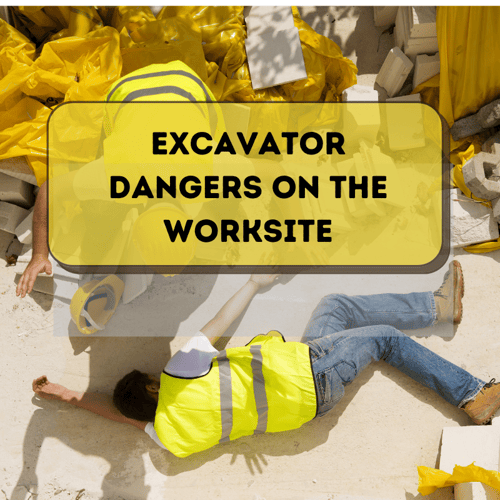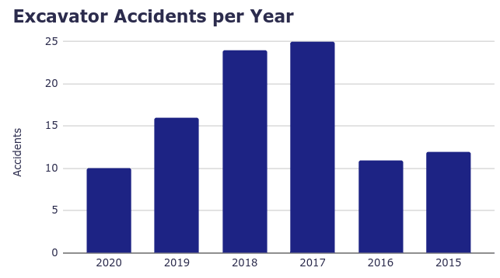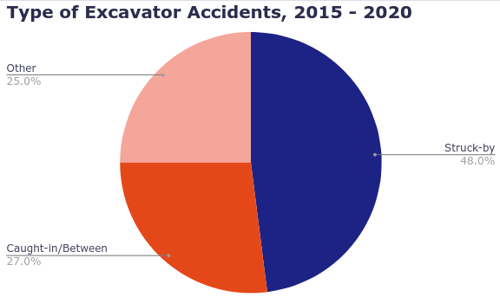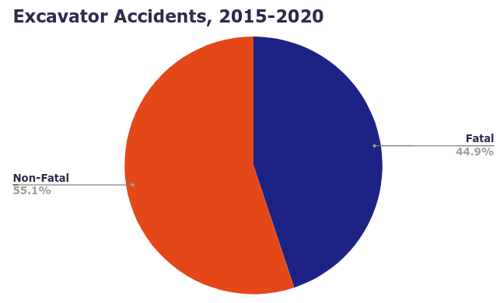How dangerous are excavators on the worksite? When used by skilled, alert operators, excavators are safe -- and indispensable. However, accidents do happen and some are a bit more common than others. Oh, and all the data you're about to see came from OSHA.

Here are some additional Shop Talk blog posts you might find interesting:
- Tragic Skid Steer Accident Involves Little Boy
- Man Killed in Bobcat Skid Steer Loader Accident
- Maintaining the Final Drive on Your Excavator
OSHA on Excavator Accidents
OSHA (Occupational Safety and Health Administration) keeps detailed records of accidents and fatalities related to the American workforce. Between 2015 and 2020, OSHA reports 98 incidents involving excavators -- with almost 45% of those accidents being fatal. And that last statistic regarding fatality is worrisome. And keep in mind that even though an accident might be non-fatal, it might still have resulted in serious disability.
Excavator Accidents by Year
According to OSHA’s available data between 2015 - 2020, the year 2017 reported the highest number of work-related excavator accidents, with 2020 having the lowest number. This reduction in excavator accidents might be due to a renewed emphasis on construction site safety, such as OSHA’s Construction Focus Four training (Falls, Caught-In/Between, Struck-by, Electrocution).

Fortunately, the trend from 2017 onward shows a reduction in yearly excavator accidents that were reported.
Common Excavator Accidents
The vast majority of excavator accidents are classified as “struck-by,” which tracks well with OSHA’s general data on construction site accidents and fatalities. Crushed/pinned (or caught-in/between) is the second most common category for accidents associated with excavators, which also ties in with the OSHA Fatal Four.

Another source of information on construction site accidents and fatalities is CPWR, formerly known as the Center to Protect Workers' Rights and now the Center for Construction Research and Training. In their Data Bulletin from February 2021, they discuss the prevalence of fatal injuries related to caught-in/between accidents.
Other types of accidents involve the following:
- Excavator Roll-Over or Falling, where someone is trapped when the excavator either rolls, tips over, or falls off a surface
- Falling Off an Excavator, where someone is somewhere on the body of the excavator and either slips or falls off
- Ejecting from an Excavator, which often happens with excavator rollovers
- Run Over by an Excavator, where someone is run over by the excavator and can include being backed over
- Falling Debris, such as trees being pushed over or demolition activities
- Electrocution, when the excavator makes contact with live power
Examples of Excavator Accidents
Let’s take a look at a few of these accidents. A typical example of a roll-over involves an excavator tipping over while traveling up a hill with too steep a grade. In an accident from 2001, the operator was able to jump free of the excavator but it fatally fell on another employee.
In 2021, an OSHA accident report discusses the death of an operator when a massive tree fell upon the cab and crushed him. Electrocution can take several different forms. For example, in 2007 an OSHA excavator accident report describes an incident where an excavator was moving a 20” iron water pipe into position when it came too close to 14,400-volt, C-phase overhead power lines -- and the employee touching the pipe was killed when the arc occurred.
Conclusion
While excavators are safe when used by trained, alert operators, unforeseen accidents can still happen. Stay safe out there, everyone!



